
Cephalissa is a monotypic moth genus in the family Geometridae. Its only species, Cephalissa siria, the orange triangle moth, is endemic to New Zealand. This species has been classified as nationally vulnerable by the Department of Conservation.

Austrocidaria parora is a species of moth of the family Geometridae. It is endemic to New Zealand.

Heterocrossa iophaea is a species of moth in the family Carposinidae. It is endemic to New Zealand.

Pasiphila cotinaea is a species of moth in the family Geometridae. It is endemic to New Zealand. Its larvae feed off Olearia species and the adult moth can be seen on the wing from November to April. This species is regarded as rare.

Ichneutica omicron is a species of moth in the family Noctuidae. It is endemic to New Zealand and found only in the middle and lower parts of the North Island. It is very similar in appearance to its sister species Ichneutica barbara. The life history of this species is unknown as are the host species of the larvae. The adults are on the wing in November and December. This species is classified as "At Risk, Naturally Uncommon" by the Department of Conservation.
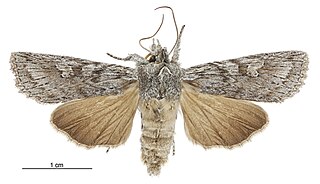
Physetica phricias is a moth of the family Noctuidae. It is endemic to New Zealand. It is wide spread in the South Island and inhabits shrubland. The host of the larvae of this species is matagouri. The adult moths are on the wing from September to May and July, and are attracted both to light and sugar traps.They are a faster-flying species and remain active even during windy conditions. P. phricias can be confused with some forms of P. sequens. However P. phricias can be distinguished as it has a less marbled appearance to its forewing.

Ichneutica blenheimensis is a species of moth in the family Noctuidae. It is endemic to New Zealand and is found throughout the North, South and the Stewart Islands. This species appears to prefer drier eastern localities and is rarely collected in western North Island forested areas. It does not appear to be frequently collected in inland dry tussock grassland habitats. The host plant for the larvae of this species is likely to be the golden sand sedge pīngao which is now absent from the moths type locality. However Chappell has raised very young larvae on grass species and the more developed larvae consumed Phormium tenax. Adults are on the wing from November to March and are attracted to both light and sugar traps. The blackish forewing fringes are diagnostic of this species. But worn specimens of I. arotis can be confused with worn specimens of I. blenheimensis. However I. arotis can be distinguished from I. blenheimensis as it has a scale-tuft on the thorax and dark longitudinal stripes on the tegula. This species is classified as "At Risk, Naturally Uncommon" by the Department of Conservation.

Chersadaula ochrogastra is a species of moth in the family Oecophoridae. This species is endemic to New Zealand. It is classified as "Data Deficient" by the Department of Conservation.

Pyrgotis pyramidias is a species of moth in the family Tortricidae. It is endemic to New Zealand. It is classified as "At Risk, Naturally Uncommon" by the Department of Conservation. This species is regarded as having two 'forms' although doubt has been expressed whether these are the same species.

Asaphodes chlamydota is a moth in the family Geometridae. It is endemic to New Zealand, and can be found in the lower part of the North Island and in the South Island. It inhabits native forest and shrublands. The larvae of this species feeds on native Clematis plants including Clematis afoliata. Adults are on the wing from November to April and are regarded as having intermedia flight powers.

Asaphodes obarata is a moth in the family Geometridae. It is endemic to New Zealand and has been collected in both the North and South Islands. It seems to inhabit the margins of native forest and also frequents plains with an affinity for gorse hedges. The host plants of the larvae of this species are unknown. The adults are on the wing in December and January. It is classified as critically endangered by the Department of Conservation. There has been a contraction of range of A. obarata with it now being regarded as locally extinct in both Dunedin and Invercargill.

Dasyuris partheniata is a species of moth in the family Geometridae. It is endemic to New Zealand. It is classified as "At Risk, Declining" by the Department of Conservation.
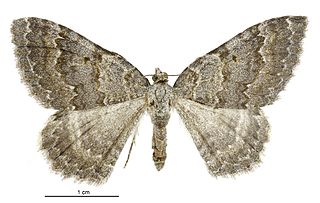
Gingidiobora subobscurata is a species of moth in the family Crambidae. It is endemic to New Zealand. This species has been classified as "At Risk, Declining" by the Department of Conservation.

Hydriomena clarkei is a species of moth in the family Geometridae. This species is endemic to New Zealand. It is classified as "At Risk, Declining'" by the Department of Conservation.
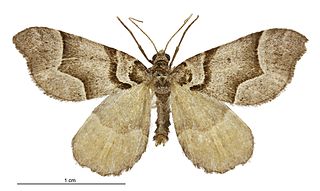
Helastia siris is a moth of the family Geometridae. This species is endemic to New Zealand. It is classified as "At Risk, Relict'" by the Department of Conservation.

Meterana exquisita is a species of moth in the family Noctuidae. This species is endemic to New Zealand. It is classified as "At Risk, Relict'" by the Department of Conservation.
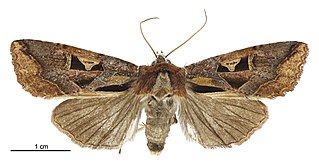
Meterana grandiosa is a species of moth in the family Noctuidae. This species is endemic to New Zealand. It is classified as "At Risk, Relict'" by the Department of Conservation.
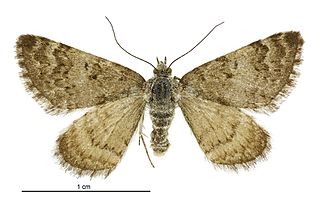
Paranotoreas fulva is a species of moth in the family Geometridae. This species is endemic to New Zealand. It is classified as "At Risk, Relict" by the Department of Conservation.
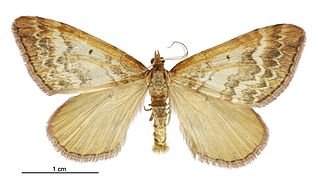
Asaphodes helias is a species of moth in the family Geometridae. It is endemic to New Zealand. It has been found in the middle and southern parts of the South Island. This species frequents tussock and scrubby habitat. The host plants of the larvae of this species include Cardamine and Ranunculus species. They have also been witnessed feeing on exotic buttercup species in the genus Bellis. Adults are on the wing in January and February.

Paranotoreas brephosata is a species of moth in the family Geometridae. This species is endemic to New Zealand.





















